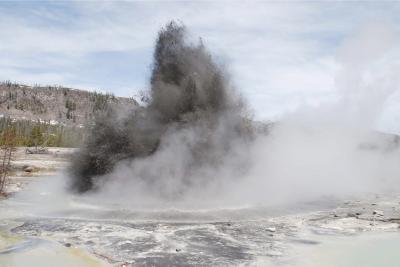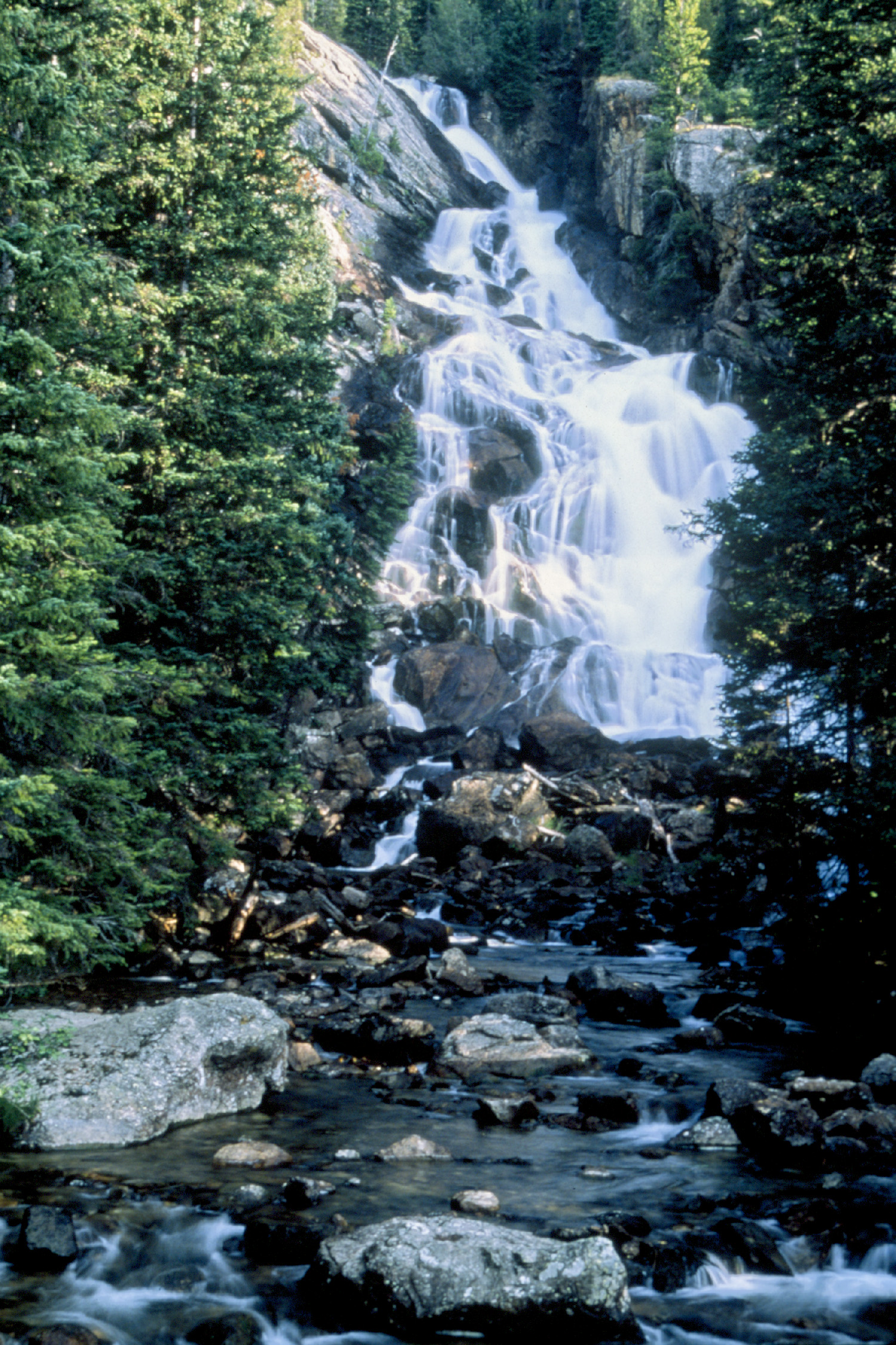Excerpted from Kiss Your Ash Goodbye: The Yellowstone Supervolcano,
© 2018
By Stephanie Osborn
Images in this article are public domain unless otherwise
noted.
What Would Happen If Yellowstone Erupted Today?
That would depend on the type of eruption. Because, you see,
sometimes Yellowstone vomits, sometimes it coughs, and sometimes it only
sneezes.
The Sneeze: Hydrothermal/Phreatic Eruptions
A hydrothermal or phreatic eruption is by far the most common
occurrence at Yellowstone. Put simply, it’s a cross between a boiler explosion
and a geyser, and at least at Yellowstone, often leaves new geysers or hot
springs in its wake. The USGS’s definition is as follows: “[A hydrothermal
eruption is an] explosion that can occur when hot water within a volcano’s
hydrothermal (hot water) system flashes to steam, breaking rocks and throwing
them into the air.” And often throwing them a good distance...though NOT nearly
as far as a standard volcanic eruption can chuck a lava bomb.
It does happen, and has happened in living memory — Porkchop
Geyser in the Norris Geyser Basin was formed in this fashion in 1989. More
historically, Excelsior Geyser generated a large, violent hydrothermal eruption
in 1888, which was captured on film; it had been erupting in this fashion off
and on through the 1880s-90s. Duck Lake, the ENTIRE LAKE, is the crater formed
by such a hydrothermal eruption.
Hydrothermal explosion at Biscuit Basin in Yellowstone
National Park.
Credit: USGS
IMPORTANT NOTE: Even when not in an active eruption,
Yellowstone’s hydrothermal features are dangerous; some 22 people have died
from falling into scalding hot springs since records began in 1870. One of the
most recent, which occurred in 2016 in or in the near vicinity of Porkchop,
resulted in the partial dissolution of the body before it could be recovered,
thanks to the fact that the spring was essentially boiling acid; park rangers
said had it taken much longer to recover the body, there would have been no
body left to recover. (What was the victim going to do, according to his
sister, who saw the whole horrible thing? He was going to take a hot tub bath
in it. He fell in while trying to take the temperature of the water, when the
thin, fragile mineral deposit on which he stood gave way.)
Yellowstone is far from the only volcano which generates such
eruptions; I have been present for numerous such eruptions at Mount Saint
Helens. There, they are usually called phreatic eruptions, and may carry some
ash along with the steam vents. They are fairly common occurrences, and take
place anywhere there is snow, ice, or other groundwater source in close
proximity to magma.
Hydrothermal eruptions at Yellowstone are localized to the
vicinity of the explosion, and do not affect the park as a whole. They can
present a danger to bystanders, however, if observers are in the way of either
the large rock ejecta or the scalding and often highly acidic water/steam.
This is THE MOST LIKELY TYPE OF ERUPTION to occur at
Yellowstone.
The Cough: Ordinary Eruptions
The last “ordinary” eruption to occur at the Yellowstone
hotspot happened only 70,000 years ago — yesterday, geologically-speaking.
These tend to form fairly common lava flows, and may be somewhat eruptive
(though trap-type flows have also occurred, according to geological evidence).
It would devastate the park, and possibly some of the surrounding land,
depending on exactly where and how the lava surfaced, but would not necessarily
induce a supervolcanic eruption if there is insufficient pressure, or if the
“surface shadow” of the underground melt is not large.
This is the second most likely type of eruption to occur at
Yellowstone.
Yellowstone caldera’s northwest rim at Madison Junction in
Yellowstone National Park.
Note the presence of two overlapping lava flows from
“ordinary” volcanic eruptions.
Credit: USGS.
The Vomit: Super-eruptions
Super-eruptions take a fairly long time to develop, but as
they progress, they accelerate. It can take anywhere from millennia to mere
decades for the magma chamber to inflate and the signs to manifest, but once
the chamber roof cracks all the way through from the surface, the rest takes
place in a matter of minutes to seconds.
Once the cap has broken up, a giant plume develops some
12-20mi (20-32km) high. The initial plume collapses to form a giant pyroclastic
flow that wipes everything out within 60-100mi (100-160km). Anything closer
than 125-200 mi (200-325 km) is buried under vast amounts of ash and
roofed/covered structures collapse within hours to days; aircraft can no longer
fly over western USA/Canada, rapidly progressing to all of North America as the
ash cloud spreads. Vehicles stall when air intakes choke on ash. Mud flows form
in rainy areas. The first cases of silicosis develop. The ash cloud sweeps
worldwide, reaching Europe in ~3 days. Global temperatures drop, and Earth
enters a volcanic winter.
Modeled Extent of Ashfall in a Modern Super-eruption
Even Chicago would get up to an inch or more of ash, and the
East Coast gets a solid dusting. The west coast of USA, Canada, and northern
Mexico get no favors, either. The grain belt would be devastated in a matter of
hours.
Some FEMA researchers estimate the US could take as much as
$3 trillion in damage/loss. Other experts say that as much as 2/3 of the USA
could be rendered uninhabitable.
The modeled extent of ashfall,
with depth decreasing with
increasing distance,
of a modern-day Yellowstone supereruption.
Credit: USGS.
Don’t Panic!
A supereruption is the LEAST likely type of eruption to
occur. There are far too many panic-mongers out there.
The 2018 “Incident” That Wasn’t
While I was writing the ebook, I was pinged on social media
about A DREADFUL SITUATION! OH NOES! HUGE FISSURE OPENS UP INSIDE YELLOWSTONE
SUPERVOLCANO, AREA AROUND FISSURE CLOSED! ERUPTION IMMINENT!!! or impressions
to that effect.
Well, I took one good look at the article’s source and
snorted. And then I got busy researching.
It turns out there was a JOINT FRACTURE in the rock above
Hidden Falls in GRAND TETON NATIONAL PARK, NOT Yellowstone National Park, and
some SIXTY MILES (100km) from Yellowstone. The crack was HORIZONTAL (not
vertical, therefore NOT able to reach down toward a magma chamber, which does
not currently have sufficient melt in it to even inflate, anyway), and was
considered a rock fall hazard, hence the real reason why the immediate area was
closed by the Park Service. Cause of the fracture was most likely the usual
freezing/thawing process that causes such things in mountain ranges.
Hidden Falls in Grand Tetons National Park.
Credit: National Parks Service.
The 2004 Incident
In 2004, there was a small kill-off of animals in
Yellowstone, notably about half a dozen bison, in a hollow along the Gibbon
River inside the park. This, as well as the slight inflation of the Yellowstone
Lake bed, resulted in significant concern among both geologists and the public
that the magma chamber was inflating and the caldera becoming active.
A nursery group of bison cows and calves makes its way through Lamar Valley in
Yellowstone. Credit: National Parks Service/Neal Herbert.
However, that proved not quite the case.
You see, the caldera area “breathes.” Elevations go up and
down by small amounts. Sometimes this is because the magma chamber is
inflating, and sometimes it isn’t. In this case, the DEEP chamber (NOT the
shallow chamber, from whence an eruption comes) had in fact had fresh magma
pumped in, but the quantity was small, and it periodically slows, stops, or
even reverses. Scientists believe this is because the “fresh” magma, upon
reaching the bottom of the upper chamber, then flows away through deep
horizontal vents (rather like what Kilauea is doing now), to cool and form
plutons — small to very large bodies of underground, intruded, solidified
igneous rock.
Often this ground swell is also because there is a tremendous
quantity of ground water heated by the (mostly-solid but still hot) upper magma
chamber. And when water is heated, it expands. As the heated ground water ebbs
and flows, the ground in the area swells and shrinks. This, in turn, tends to
change the activity of the hydrothermal features, increasing or decreasing with
the pressure of ground water.
That last bit is important, because the animal-kill event
occurred shortly after a cold front passage, when the air was frigid and still,
and the animals took shelter in a low-lying area near the river, where those
same hydrothermal features would help keep the air warm, and make foraging for
food easier. Hydrothermal features such as those found nearby are also known to
emit toxic volcanic gases such as sulfur dioxide, hydrogen sulfide, and carbon
dioxide, often in significant quantities, WITHOUT the need for an eruptive
event — pretty much continuously. And these gases, mostly being heavier than
air, tend to flow along the ground and collect in low-lying areas. Normally,
the winds in the region keep the air sufficiently stirred that concentration is
not particularly dangerous, but certain meteorological conditions — such as
those brought about by the cold front passage — can result in air that is
sufficiently still to allow the vapors to collect and concentrate, and this
appears to be what happened in 2004.
And this has happened before, several times in recorded
history. This does NOT mean that the caldera is preparing to erupt. Nor does it
mean that such an eruption, IF it took place, would automatically be a
supereruption, as “ordinary” eruptions are more common, based on geologic
studies.
But What if it DID erupt?
What do you do?
Kiss your ash goodbye...?
No, seriously. What do you do?
In all seriousness? Unfortunately, there are some natural
disasters for which it simply isn’t possible to do a lot of advance
preparation. They are simply too big, too widespread, and too variable, to make
plans. Supervolcano eruptions are one of these. Physicist Michio Kaku said it
best, I think...
“All you can do is run.”
~Michio Kaku
To obtain a copy of Kiss
Your Ash Goodbye: The Yellowstone Supervolcano by Stephanie
Osborn, go to: bit.ly/Kin-KYAGTYSV.





